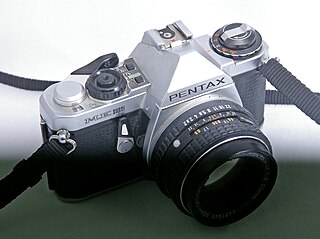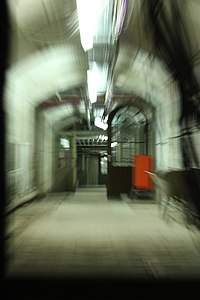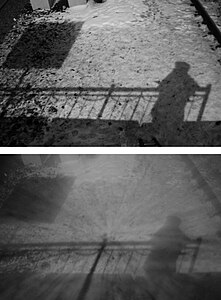
A camera is an optical instrument that captures images. Most cameras can capture 2D images, while some more advanced models can capture 3D images. At a basic level, most cameras consist of a sealed box with a small hole that allows light to pass through and capture an image on a light-sensitive surface. Cameras have various mechanisms to control how light falls onto the light-sensitive surface, including lenses that focus the light and a shutter that determines the amount of time the photosensitive surface is exposed to the light.

A pinhole camera is a simple camera without a lens but with a tiny aperture —effectively a light-proof box with a small hole in one side. Light from a scene passes through the aperture and projects an inverted image on the opposite side of the box, which is known as the camera obscura effect. The size of the images depends on the distance between the object and the pinhole.

In photography, shutter speed or exposure time is the length of time that the film or digital sensor inside the camera is exposed to light when taking a photograph. The amount of light that reaches the film or image sensor is proportional to the exposure time. 1⁄500 of a second will let half as much light in as 1⁄250.

In photography, exposure is the amount of light per unit area reaching a frame of photographic film or the surface of an electronic image sensor, as determined by shutter speed, lens F-number, and scene luminance. Exposure is measured in lux seconds, and can be computed from exposure value (EV) and scene luminance in a specified region.

Motion blur is the apparent streaking of moving objects in a photograph or a sequence of frames, such as a film or animation. It results when the image being recorded changes during the recording of a single exposure, due to rapid movement or long exposure.

In photography, flash synchronization or flash sync is the synchronizing the firing of a photographic flash with the opening of the shutter admitting light to photographic film or electronic image sensor.
In photography, bracketing is the general technique of taking several shots of the same subject using different camera settings, typically with the aim of combining the images in postprocessing. Bracketing is useful and often recommended in situations that make it difficult to obtain a satisfactory image with a single shot, especially when a small variation in exposure parameters has a comparatively large effect on the resulting image. Given the time it takes to accomplish multiple shots, it is typically, but not always, used for static subjects. Autobracketing is a feature of many modern cameras. When set, it will automatically take several bracketed shots, rather than the photographer altering the settings by hand between each shot.

In infrared photography, the film or image sensor used is sensitive to infrared light. The part of the spectrum used is referred to as near-infrared to distinguish it from far-infrared, which is the domain of thermal imaging. Wavelengths used for photography range from about 700 nm to about 900 nm. Film is usually sensitive to visible light too, so an infrared-passing filter is used; this lets infrared (IR) light pass through to the camera, but blocks all or most of the visible light spectrum.
The science of photography is the use of chemistry and physics in all aspects of photography. This applies to the camera, its lenses, physical operation of the camera, electronic camera internals, and the process of developing film in order to take and develop pictures properly.

When setting photoflash exposures, the guide number (GN) of photoflash devices is a measure photographers can use to calculate either the required f‑stop for any given flash-to-subject distance, or the required distance for any given f‑stop. To solve for either of these two variables, one merely divides a device's guide number by the other.

In photography and optics, a neutral-density filter, or ND filter, is a filter that reduces or modifies the intensity of all wavelengths, or colors, of light equally, giving no changes in hue of color rendition. It can be a colorless (clear) or grey filter, and is denoted by Wratten number 96. The purpose of a standard photographic neutral-density filter is to reduce the amount of light entering the lens. Doing so allows the photographer to select combinations of aperture, exposure time and sensor sensitivity that would otherwise produce overexposed pictures. This is done to achieve effects such as a shallower depth of field or motion blur of a subject in a wider range of situations and atmospheric conditions.

Image stabilization (IS) is a family of techniques that reduce blurring associated with the motion of a camera or other imaging device during exposure.

In cinematography and photography, panning means swivelling a still or video camera horizontally from a fixed position. This motion is similar to the motion of a person when they turn their head on their neck from left to right. In the resulting image, the view seems to "pass by" the spectator as new material appears on one side of the screen and exits from the other, although perspective lines reveal that the entire image is seen from a fixed point of view.
The following outline is provided as an overview of and topical guide to photography:

Sports photography refers to the genre of photography that covers all types of sports.

Long-exposure, time-exposure, or slow-shutter photography involves using a long-duration shutter speed to sharply capture the stationary elements of images while blurring, smearing, or obscuring the moving elements. Long-exposure photography captures one element that conventional photography does not: an extended period of time.

Landscape photography shows the spaces within the world, sometimes vast and unending, but other times microscopic. Landscape photographs typically capture the presence of nature but can also focus on human-made features or disturbances of landscapes. Landscape photography is done for a variety of reasons. Perhaps the most common is to recall a personal observation or experience while in the outdoors, especially when traveling. Others pursue it particularly as an outdoor lifestyle, to be involved with nature and the elements, some as an escape from the artificial world.
In photography, a long-focus lens is a camera lens which has a focal length that is longer than the diagonal measure of the film or sensor that receives its image. It is used to make distant objects appear magnified with magnification increasing as longer focal length lenses are used. A long-focus lens is one of three basic photographic lens types classified by relative focal length, the other two being a normal lens and a wide-angle lens. As with other types of camera lenses, the focal length is usually expressed in a millimeter value written on the lens, for example: a 500 mm lens. The most common type of long-focus lens is the telephoto lens, which incorporate a special lens group known as a telephoto group to make the physical length of the lens shorter than the focal length.

In intentional camera movement (ICM), a camera is moved during the exposure for a creative or artistic effect. This causes the image points to move across the recording medium, producing an apparent streaking in the resulting image.

Google Camera is a camera phone application developed by Google for the Android operating system. Development for the application began in 2011 at the Google X research incubator led by Marc Levoy, which was developing image fusion technology for Google Glass. It was publicly released for Android 4.4+ on the Google Play Store on April 16, 2014. It was initially supported on all devices running Android 4.4 KitKat and higher, but became only officially supported on Google Pixel devices in the following years.



















